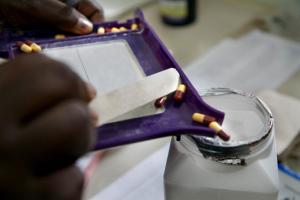New WHO Guidelines Make All Persons Living with HIV Eligible for Antiretroviral Treatment
Johannesburg, 29 April 2016 – According to the new World Health Organization (WHO) guidelines for the prevention, treatment and care of HIV and Hepatitis, all 26 million people currently living with HIV in the African Region are now eligible for antiretroviral treatment (ART). This is more than double the number of the current 11 million on treatment.
“The recommendation that anyone infected with HIV should begin antiretroviral treatment as soon as possible after diagnosis will revolutionize treatment outcomes, where people living with HIV will be able to live long and healthy lives,” says Dr Matshidiso Moeti, WHO Regional Director for Africa, “WHO AFRO will work with countries to provide technical support in the transition from current treatment modalities, to ease burden on national health systems.”
With its “treat-all” recommendation, WHO removed all limitations on eligibility for anti-retroviral therapy (ART) among people living with HIV – all populations and age groups are now eligible for treatment. In the past, people living with HIV had to fulfil certain criteria before receiving treatment.
The expanded use of anti-retroviral treatment is supported by recent findings from clinical trials confirming that early use of ART keeps people living with HIV alive and healthier, and reduces the risk of transmitting the virus to partners.
WHO now also recommends that anyone at “substantial” risk of becoming infected should be offered preventive anti-retroviral treatment, termed as pre-exposure prophylaxis (PrEP). PrEP should be seen as an additional prevention choice based on a comprehensive package of services, including HIV testing, counselling, voluntary male medical circumcision, access to condoms and safe injection equipment.
In addition to the new directions towards expanding ART access to all people living with HIV and broader use of PrEP, the consolidated guidelines make new clinical recommendations on preferred antiretroviral drugs and regimens, new testing strategies for infants, the increasing role of viral load and the appropriate use of CD4 testing. Service delivery recommendations will focus on interventions to reduce losses along the cascade of HIV services from testing to viral suppression, and the role of community-based models of ART delivery.
The WHO guidelines for the prevention and control of HIV and Hepatitis were discussed in detail with 18 countries in the African Region at a workshop held in Johannesburg, South Africa, on 25–29 April 2016.
During the workshop, countries engaged in dialogue on operational and programmatic implications for adoption and implementation of the strategies and guidelines on national health systems. Country plans for in-country dialogue and technical assistance needs for adaptation and implementation were also identified. Countries also developed draft country roll-out plans, including the priority actions for country adaptation along with technical assistance that may be required for timely and effective implementation of the new guidelines.
__________________________________
For more information, please contact:
Dr Frank Lule, Regional Adviser, HIV Programme lulef [at] who.int (lulef[at]who[dot]int) Tel +47-241-39162,
Loza Mesfin Tesfaye, Communications Officer tesfayel [at] who.int (tesfayel[at]who[dot]int) Tel +47-241-39779
C. Boakye-Agyemang, Regional Communications Adviser boakyeagyemangc [at] who.int (boakyeagyemangc[at]who[dot]int) Tel +47-241-39420



